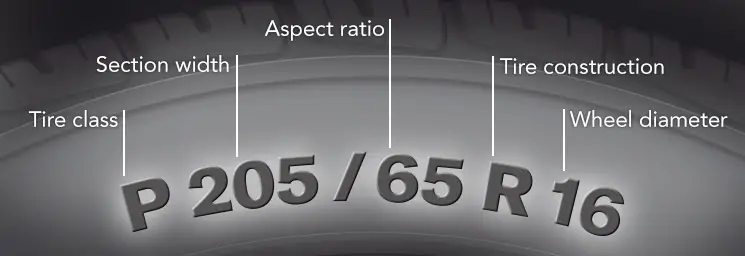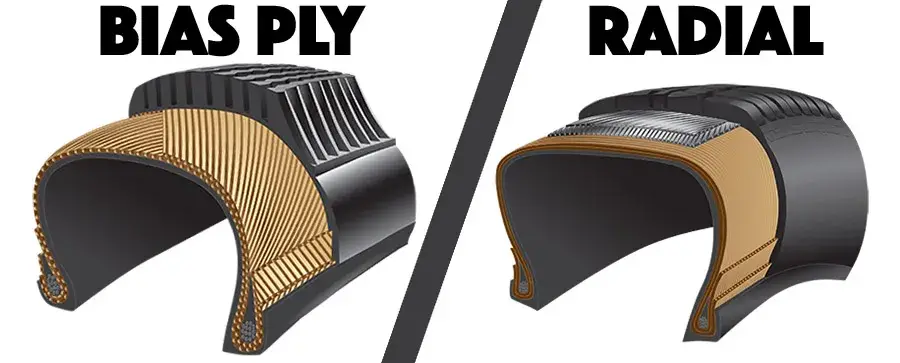6.50-16 tires are commonly used on older vehicles. If you want to find a modern equivalent of this tire, you have to know the proper conversion process.
So, what is the 6.50 16 tire conversion?
The radial tire conversion of 6.50 16 bias-ply tires is 165.1/ 75 R 16 if the aspect ratio is 75%. For an 80% aspect ratio, the conversion is 165.1/ 80 R 16. You can use some other tires as its equivalent as well. For example, 180/95 R 16, 215/75 R 16, 225/75 R 16, and 245/70 R 16.
In this article, I will explain the 6.50-16 tire size and its conversion to more modern tire sizing standards. So, keep reading.
What Size Is A 6.50 16 Tire?
A 6.50-16 tire size is a type of bias-ply tire with a section width of 6.50 inches and a rim diameter of 16 inches. It can also be written as 650 – 16. This type of tire is commonly used on older pickup trucks, vans, and tractors.
How To Convert 6.50 16 Bias-Ply Tire To Radial?
To convert 6.50 16 bias ply to radial you have to measure the wheel and do some calculations.
Step 1: Calculating Section Width
The section width of a tire is the width of the tire’s tread, measured from the widest point from sidewall to sidewall.
You can watch this video to understand how to measure the wheel properly.
To convert the section width from inches to mm we have to use the following format.
Section Width (mm) = Section Width (inches) × 25.4
Here,
Section Width (mm) = 6.50 inches x 25.4 = 165.1 mm.
Step 2: Calculating Sidewall Aspect Ratio
The sidewall aspect ratio of a tire is the ratio of the height of the tire’s sidewall to the tire’s width. This ratio is a two-digit number expressed as a percentage.
As there is no aspect ratio mentioned, generally we can let the aspect ratio be 75%. It is the standard measurement.
You can also get 80%, 85%, 90%, and so on as aspect ratios. It depends on your tire height and width.
Step 3: Changing the Internal Construction Code
The internal construction code of a tire is a letter that indicates the type of construction used in the tire’s construction. There are two main types of tire construction which are radial and bias-ply.
The internal construction code “R” indicates that the tire has a radial construction, while “B” indicates that the tire has a bias-ply construction.
As we are converting to radial, for us, the code will be “R”. This lettering alongside section width and aspect ratio is permanently engraved on the tire. They are not like the temporary blue markings that can be cleaned off from new tires.

Step 4: Calculating Wheel Diameter Size
Wheel diameter is the distance across the wheel at its widest point. It is measured from one end of the wheel’s rim to the other, passing through the center point. For our given tire, the wheel diameter is 16 inches.
Now, here’s the table for possible 6.50 16 tire conversion.
| Aspect Ratio | Converted in radial size |
| 75% | 165.1/ 75 R 16 |
| 80% | 165.1/ 80 R 16 |
| 85% | 165.1/ 85 R 16 |
| 90% | 165.1/ 90 R 16 |
| 95% | 165.1/ 95 R 16 |
However, as these tires are used in light trucks, the 165.1 mm tire will look shorter. Even, a 175 mm tire will look short on a light truck. Also, it is very hard to find a 175mm tire in the market.
So, some car owners like to use 85-series of radial tires instead of 6.50 16-tire bias ply tires. So, these can be your options as well.
- 180/95 R 16
- 225/75 R 16
- 245/70 R 16
- 215/75 R 16
You can also do the 9.50-16.5 bias-ply tire conversion using the same process.
Bias Ply Vs Radial Tire

As you are thinking about converting from bias-ply tires to radial. You should know the difference between them. It will give you a clear idea of what advantages and disadvantages you should expect after the conversion.
- Unlike bias-ply tires, the radial tire is widely available in the market with numerous variations and sizes.
- Radial tires provide more precise handling, cornering, and turning than bias- ply tires. So, in terms of performance, you will get better performance from radial tires than bias-ply tires.
- Radial tires are better in terms of traction than bias-ply tires due to fewer plies.
- Radial tires are better at dissipating heat than bias-ply tires.
- Radial tires will last for a longer time than bias-ply tires. Bias-ply tires tend to wear out pretty fast.
- Radial tires are more complicated and costly to repair than bias-ply tires.
- As radial tires are more complex to produce, they are more expensive than bias-ply tires.
- You will get better performance from bias-ply tires than radial tires in rough or hilly terrain.
- As the tread of the radial tires is rugged, they tend to be very noisy, unlike bias-ply tires. Radial tires have a lower load capacity than bias-ply tires.
So, you have to consider these factors as well before switching to radial tires. Also, consider the rim and tire compatibility as well. For example, if you want to use a 275 mm tire on an 8” rim, you should first know if they are compatible.
Frequently Asked Questions (FAQs):
What Is A 7.50-16 Tire Equivalent?
The 7.50-16 bias-ply tire equivalent radial tire is 190.5/80 R 16 if the aspect ratio is 80%. If the aspect ratio is 75%, the equivalent tire would be 190.5/75 R 16. However, if you consider availability, 235/80R16 is the most available and closest tire of 7.50-16.
What Does Bias Ply Mean?
Bias ply is a type of tire construction where the tire’s zigzag cords are laid at diagonal angles from bead to bead, creating a crisscross pattern. This design provides better load-carrying capacity than the radial tire.
Why Are Bigger Tyres Better?
Bigger tires are better because they provide benefits such as improved ground clearance, increased traction, and better handling. These tires help reduce the braking distance which leads to increased safety.
Conclusion
Here goes everything on 6.50 16 tire conversion you needed to know. Hope this article will be helpful. Although an expensive transmission, radial tires will give you the advantage of a long-term investment and a better driving experience.
That’s all for now. All the best and have a great day!
